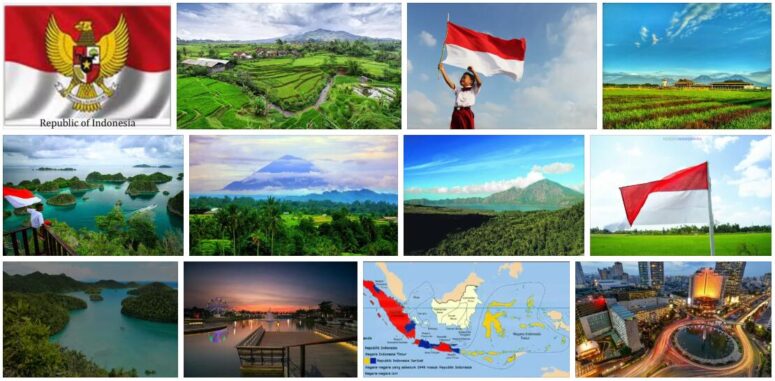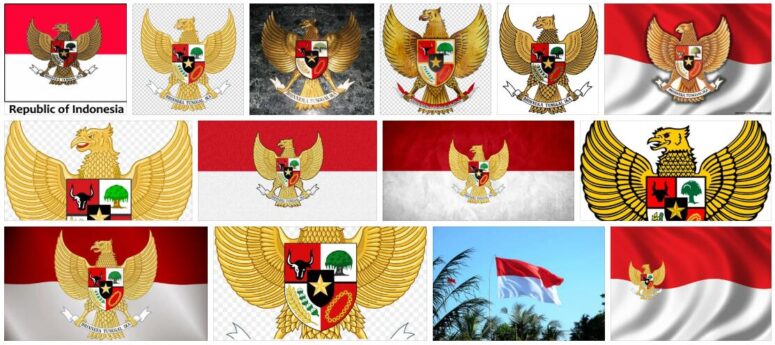Indonesia is the largest island nation in the world. It lies on both sides of the equator in Southeast Asia. The country is extremely volcanic. About 70 volcanoes are still active today. Earthquakes shake the country at regular intervals. Floods caused by large fluctuations in discharge between the rainy and dry seasons lead to major damage, as does forest fires.
Indonesia is a multi-ethnic state. One tries to counter the problem of overpopulation through resettlement projects (so-called Transmigrasi) in peripheral areas of the country. The economic boom in Indonesia in the 90’s is based on a strong agriculture with rice cultivation, a raw material industry for export and tourism.
Short for ID on ABBREVIATIONFINDER.ORG, Indonesia comprises the main part of the Malay Archipelago with the Great Sunda Islands Borneo (Kalimantan, without the northwest), Sumatra, Java and Celebes (Sulawesi), the Lesser Sunda Islands, the Moluccas and Irian Jaya (Fig. 1).
Of the 13,677 islands in Indonesia, 6044 are inhabited. The east-west extension of Indonesia is almost 5100 km, the north-south extension up to 1888 km. The distance from east to west corresponds roughly to the distance from Baku on the Caspian Sea to Lisbon on the Atlantic.
Important data about the country
| Surface: | 1,912,988 km² |
| Residents: | 222.6 million |
| Population density: | 117 residents / km² |
| Growth of population: | 1.3% / year (1999) |
| Life expectancy: | 67 years |
| State capital: | Jakarta |
| Form of government: | Presidential republic since 1945 |
| Languages: | Javanese (most common mother tongue), around 170 Malayo-Polynesian languages, Dutch and Arabic as compulsory school languages |
| Religions: | Muslims 88%, Christians 8%, Hindus 2%, Buddhists, Confucians |
| Climate: | always humid tropical climate, in the east of Java and on the Lesser Sunda Islands tropical monsoon climate |
| Land use: | Arable land 11.2%, forest 67.2%, pasture land 6.6% (1990) |
| Economic sectors (share of employees): |
Agriculture 43.8%, industry 18.7%, services 37.5% |
| Export goods: | Petroleum, natural gas, chemical products, tin, rubber, coffee, tea, spices |
| Gross domestic product: | $ 208,312 million (2003) |
| Gross National Product: | US $ 810 / residents (2003) |
Surface shape
No other country has such a strong natural geographical division into countless large and small units as Indonesia. The contrasts between land and sea, plains and mountains are hardly as diverse anywhere else as on the Indonesian archipelago. With the exception of the land mass of Borneo, all of the islands in Indonesia lie on the border between two continental plates. The Indo-Australian plate is drifting northeast towards the Eurasian plate in the Indonesian arch. The result is tectonic movements. Earthquakes and volcanic eruptions are characteristic of Indonesia. The landscape of Indonesia is characterized by high mountains. Soaring fold mountains crisscross the island kingdom. The mountain ranges are extremely rich in volcanoes. Of the total of 300 volcanoes, 70 are still active. The highest point in the country, which is located in the glaciated central mountains of New Guinea, is Gunung Yaya with a height of 5033 m. Many other peaks are over 3000 m high, such as the Kerinci on Sumatra (3805 m), the Semeru on Java (3676 m) or the Rantemario on Celebes (3455 m). One of the most spectacular volcanoes is Krakatau. It forms a volcanic island between Java and Sumatra, which is 15 km² in size and over 800 m high. This island and two other islands represent the remainder of a former 2000 m high volcano, which exploded in 1883 with an ash ejection from 50 to 80 km height. This created a tidal wave 20 m high, claiming 36,000 victims on the coasts of Java and Sumatra. Krakatau is still one of the most active volcanoes in Indonesia with violent eruptions at regular intervals. On the coasts of the shallow seas between the island world there are wide lowlands, for example the coastal plains of Sumatra, Java and Borneo. The coasts towards the Indian Ocean, on the other hand, are cliffs.
Waters
The longest rivers in Indonesia can naturally be found on the large islands of Borneo, Sumatra and New Guinea. These include the Kapuas with a length of 1665 km, the Barito (725 km) and the Kutai on Kalimantan (840 km). The Javanese rivers are shorter (e.g. the Solo with a length of 490 km), but their importance for the irrigation of the extensive agricultural areas is great. Characteristic of the Indonesian rivers is a steep, winding meander in the coastal plains. The rivers transport huge amounts of sediment from the mountains covered by rainforests, which they deposit at the mouth of the delta. There they build alluvial alluvial plains and swamps that grow out into the sea. Another characteristic of the Indonesian rivers are large fluctuations in discharge between rainy and dry seasons, which often lead to devastating floods. For years one tries more or less successfully, the z. T. hugeTo reduce flood damage through complex construction measures (river regulation, dyke systems, retention basins). In the rainy season, the rivers are usually navigable far into the interior of the country and are therefore of great importance for the economic development of the often roadless regions.
Climate
The great variety of surface forms and the enormous dimensions of Indonesia also lead to a great variety of its climatic conditions.
With the exception of the east of Java, the Great Sunda Islands, the Moluccas and Irian Yaya are characterized by an ever-humid tropical climate. The annual rainfall is between 3000 and 4000 mm in the lowlands and up to 6000 mm in the mountains (Fig. 3). In the east of Java and the Lesser Sunda Islands there is a tropical monsoon climate with an extended humid wet rainy season and a dry season. Most precipitation, an average of 2000 to 3000 mm per year, falls between December and March. The dry season lasts from July to September. Due to its location near the equator, there are only minor temperature fluctuations in Indonesia. In the coldest month the thermometer in the lowlands reaches an average of 26 °C, in the warmest month 28 °C. The warmest month north of the equator is June and November south of it.
Vegetation
According to the climatic conditions, Indonesia’s vegetation is extremely diverse and lush. Around 30,000 flowering plants, including 5,000 species of orchids and many flowering trees such as flame tree or frangipani, grow in Indonesia. The plant with the largest single flower, the rafflesia, also thrives here. Originally, dense tropical forests covered around 60% of the country’s area. Due to clearing, but also devastating forest fires, triggered by slash and burn, the forest stocks have declined sharply in the last two decades. The forests of Indonesia have a very different face: Evergreen tropical rainforests
grow up to altitudes of around 1000 m on the western sides of the islands . This is followed by the zone of up to a height of 2500 m evergreen cloud forest. Coniferous forests then predominate in the upper peaks of the mountains.
The areas of Indonesia influenced by the monsoons are covered by monsoon forests. In these forests the trees shed their leaves during the dry season.
Finally, extensive mangrove forests grow on the coastal fringes of the shallow seas.
Economy
Industry has had the largest share in Indonesia’s economic growth in recent years. The 1997 Asian crisis ended this upswing, but Indonesia has significant economic growth potential due to its extremely rich natural resources (Fig. 6).
Agriculture
Over 40% of the country’s gainfully employed work in agriculture. The main cultivation product is rice, the main cultivation area is Java.
Year-round favorable rainfall and consistently high temperatures create good conditions for high yields here. In addition, there are very fertile and mineral-rich soils, which have mainly formed on the solidified lava ashes of the volcanoes in this region.
Despite the constant threat of volcanic eruptions and torrential rains, rice has been grown as a staple food on Java for centuries.
In the mountainous areas, terraced fields are created and irrigated. In Java and Bali you can harvest several times a year due to the favorable climatic conditions. In the agriculture of Indonesia prevails Large estate before. Most families only cultivate the smallest fields, the harvest of which is often not even sufficient for their own supply. Many farmers work as tenants for the landlords, to whom they then owe half of the harvest. Other farm workers have to hire the landowners as wages for a handful of rice.
After China and India, Indonesia is the third largest producer of rice in the world. In addition to rice, maize, cassava and vegetables are grown for local supplies.
In addition, important export crops are produced on the large plantations. Rubber, tea, coffee, cocoa, oil palm products and sugar cane are some of the country’s most important sources of foreign currency.
Natural resources and industry
The wealth of raw materials in Indonesia is the basis of the expanding industry.
Oil and gas are produced in Sumatra, Borneo and Irian Yaya. Indonesia realizes almost a quarter of its export volume with them. The country is also one of the leading exporters of tin and nickel. The extensive bauxite, hard coal and manganese deposits are also of great economic importance. In the industry of the country 19% of workers are employed.
The wood, tobacco and sugar processing, rubber processing and paper manufacturing companies, like the textile companies, primarily process the products of local agriculture. In addition, the electrical industry as well as vehicle and mechanical engineering have developed into significant branches of the economy since the 1980’s. Indonesia’s main trading partners are Japan and the USA, which account for 40% of exports, as well as the EU countries, Hong Kong, Singapore and Australia.
Tourism
For about 20 years, Indonesia has become a tourist destination. In the mid-1990’s, around 4.3 million foreign visitors visited the country. The growing tourism has thus become an important economic factor.
History
up to the 16th century: Indianization and Muslim kingdoms
1602–1908: Beginning of Dutch colonial rule, foundation of the Dutch East India Company
1908–1945: Struggle for liberation from colonial rule
1945: Proclamation of the Republic of Indonesia by its first President SUKARNO, building of a modern state
Since the 1980’s: beginning of the economic upswing with high growth rates in production, combined with growing domestic political conflicts and the like. a. by radical Islamic fundamentalist groups

